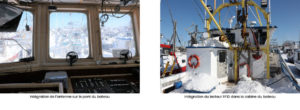June 8, 2022
Fighting against ghost fishing gears in St Laurent thanks to RFID
In Canada, more than 63 tonnes of ghost fishing gear[1] gear was recovered from the Atlantic Ocean in 2020, according to the Department of Fisheries and Oceans (ministère des Pêches et des Océans, MPO), 86% of the gear recovered was lobster and crab traps and cages. 14% came from the Gulf of St. Laurent[2]
The Quebec aquaculture and fisheries innovation center, Merinov, located in the Gaspé Peninsula, the Magdalen Islands and the North Shore, has been mandated to provide solutions to ocean pollution but also to the recycling of this ghost gear.
Economic and environmental issues
Cleaning up the ocean of ghost fishing gear is both an environmental and an economic issue: protecting biodiversity, reducing the costs of searching for lost gear at sea, facilitating the work of fishermen and fishing industry organizations, and promoting the reuse of these lost or abandoned gears.
In this context, the embedded systems unit of the ITMI (Institut technologique de maintenance industrielle), which is a college technology transfer center (CCTT) hosted by the Sept-Îles CEGEP on Quebec's north shore, proposed a solution for intelligent traceability of fishing gear. Based on RFID, a radio frequency identification technology, this solution was deployed in close collaboration with AXEM Technology.
Tracking fishing gear with RFID

The solution implemented by ITMI meets the different issues by providing :
- Accurate and continuous traceability of fishing gear during its life on the fishing boat until its arrival at the sorting center when it is collected in the ocean or simply dropped off by the fisherman because it is at the end of its life, through RFID technology. Each gear, from its production to its end of life, is identified by a unique number that constitutes its identity card. It is followed in its movements.
- Standardization and secure centralization of data in the Cloud to facilitate the search for any lost gear, its identification and then its recycling.
- Recycling of lost or abandoned gear but also at the end of its life and which the fishermen wish to get rid of.
A win/win solution
The RFID fishing gear identification project benefits everyone in the fishing industry.
- Help to fishermen who want to get rid of end-of-life gear
- Less loss of fishing gear for fishermen
- Time saving for the search of lost gear in the ocean and therefore cost reduction
- Digitization of ocean management and related activities
- Reduced risks for biodiversity
- Creation of a circular economy with fishing industry waste
How does it work?
Fishing gear (e.g. crab cage nets, ropes...) are identified by RFID tags that associate them with a unique code. They are then loaded on the fishing boat.

The boat is equipped with an embedded RFID reader that regularly scans the tags on the boat during sea trips. The data is recorded in real time in the boat’s controller.


When the boat reaches the port of Sept-Îles, the data stored in the boat's controller is sent to the Cloud with a database for secure storage. Thus, by updating the database, it is possible to check whether all the gear present in the boat when it leaves the port is also present when it returns from its fishing mission.
When the boat reaches the port of Sept-Îles, the data stored in the boat’s controller is sent to the Cloud where it is securely stored in a database. Thus, by updating the database, it is possible to check whether all the gear present in the boat when it left the port is also there when it returns from its fishing mission.
Besides, when the tags are read during the fishing trip, the GPS coordinates are also recorded, thus allowing the geolocation of the fishing gears at the place where they were lost at sea. Meanwhile, the fishing gear found at sea is also scanned at the sorting center. Thanks to the data of the UHF RFID chip, the identity card of the gear, the materials and especially the plastics that can be reused are identified.
At present, an item lost at sea can remain in the water for up to a full year before being found. If RFID technology facilitates the search for fishing gear, it does not completely prevent the lost gear from lying in salt water. Thus, selected for its durability, the RFID tag is still functional even after a stay in salt water.
[1] set of equipment used on board a specific vessel, whose function is the exploitation of a marine resource
[2] 63 tons of ghost fishing gear removed from the Atlantic Ocean in 2020 , Ici radio-canada, https://ici.radio-canada.ca/nouvelle/1761547/equipement-engins-peche-fantomes-ocean-baleines-nettoyage

